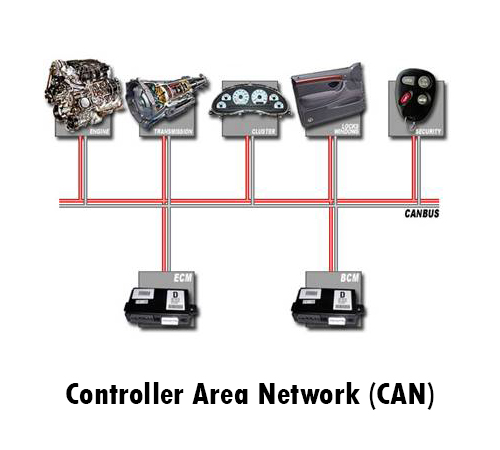Definition of controller area network (CAN)
CAN or controller area network is a type of communication network between microcontroller and devices in a vehicle. It is also known as CAN bus because a common bus is attached with all the devices of the vehicle. CAN uses serial processing that means communication between microcontroller and devices is done sequentially. If the signal is sent at the same time to the devices then the priority of the device is considered. The device which has higher priority get the signal first then the low priority device gets the signal. The devices are also known as electronic control units (ECU’s).

Before the arrival of CAN, the cabling in cars was very difficult. The length of the cables was high and it was difficult to manage all the cables. The wiring of so many cables can also increase the chances of short circuits and can heat up easily. And there were chances of a fire in the car because of heating up of wires. The weight of cables in the car also increases the overall weight of the car. To solve this problem CAN was introduced in 1986 by Bosch and Intel.
The first test of CAN was implemented in the Mercedes S class 140 model in 1990. The earlier chips of CAN were assembled in 1988. When CAN was implemented on automobiles then the cost of the overall car was reduced. CAN was a success in the car industry. Later CAN was also used in home automation, electronics, agricultural equipment’s, medical instruments and others.
CAN have two wires ( CAN high and CAN low). These wires are twisted together to make the main bus. Then the main bus is attached with all the devices. The CAN bus is attached with one device and the same cable goes to another device and so on. Suppose there are 3 devices (A,B and C) connected to the microcontroller through the main bus. If the microcontroller wants to transmit data to device C then first the data goes to device A. Device A checks the data and see that it is for device C so it redirects to device B, then device B also checks that it is for device C so it finally redirects data to device C.
The voltage in CAN high wire and CAN low wire makes different signals to the devices (ECU’s).
In CAN bus, the high voltage is 3.75V and the low voltage is 1.25V. The high and low voltage if added can give you 5V.
CAN high has a voltage between 2.5V to 3.5V.
CAN low has a voltage between 2.5V to 1.5V.
The data transfer speed of CAN goes up to 1Mbps.
What is controller area network protocol
CAN protocol is a method in which CAN operates. The two wires (CAN high wire and CAN low wire) are twisted with each other to make the main bus. Then this main bus is attached with all the electronic control units or devices. The devices may be speakers, brakes, speed meters, gears, AC control and others. The main bus (twisted cable) is attached with the first device and the same cable from the first device continues to attach with the second device and so on.
What is controller area network bus
The controller area network bus is like the main cable attaching with the devices in the automobile. It works the same way as computers are attached in bus topology. The data from the microcontroller is broadcast to all the devices (ECU’s) and if the data matches the ID of the device then that device will receive the data. Also note that at both ends of the bus, terminators are attached that will close the connection. The terminators are used to finish the current from the data signal.
Benefits of controller area network (CAN)
- Diagnosis of error is easy
- Low in cost because overall cabling in the car is reduced
- Communication is robust and data exchange also happens in hot and cold temperature
- Devices can be added or removed without affecting the communication of other devices
- Data transfers in priority that is useful in the maintenance of the car
Examples of controller area network (CAN)
- Automation in buildings
- Used in elevators
- Used in ships
- Lighting control systems
- Agricultural equipment
- Industrial automation
- Used in medical instruments




